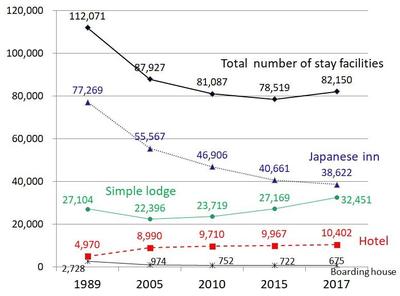Column Finance and the Social Security System 2020.06.24
【Aging, safety net and fiscal crisis in Japan】No.232: Facilities requiring stronger infection prevention measures against COVID-19
The Abe administration lifted the declaration of a state of emergency due to COVID-19 on May 25. However, to prepare for the second and third waves, various facilities where people gather are required to take measures to prevent infection.
As shown in Figure 1, the number of movie theaters fell from 2,220 in 1989 to 1,475 in 2017. The reason may be the influence of the spread of DVDs and the Internet. Until COVID-19 is completely resolved, movie theaters will need to keep the number of audience members to less than half the number of seats. This is expected to deteriorate their financial conditions and further reduce the number of movie theaters. In the sports industry, although the season of professional sports will begin at relevant facilities such as baseball and soccer fields, there will be no live audiences for a while.
As shown in Figure 2, there are four types of stay facilities: Japanese inns, hotels, simple lodges, and boarding houses for university students. The number of Japanese inns halved from 77,269 in 1989 to 38,622 in 2017. They are relatively expensive because of the high quality of services they offer, including the traditional Japanese cuisine called "Kaiseki." Furthermore, as they are traditionally family businesses, their business scale is smaller than that of hotels. As a result, customers are more inclined to choose hotels and simple lodges. As a result of COVID-19, the number of tourists has drastically reduced, and this is expected to cause a sharp increase in bankruptcies and closures. A contributing factor is that the number of hotels and simple lodges has increased in recent years as the influx of foreign tourists was expected to increase during the 2020 Tokyo Olympics. However, this too has been complicated by the COVID-19 situation.
Figure 3 shows the number of hairdressing salons and barbershops. The number of hairdressing salons, whose main customers are adult women, is steadily increasing. In contrast, barbershops targeting men and children are decreasing. The reason for this may be the rise of barbershops, which only offer haircuts without additional services such as shaving and washing hair.
The Public Bathhouse Law defines two types of bathhouses: general public bathhouse and other public bathhouse. A general public bathhouse is a necessary facility that local residents use for health and hygiene in their daily lives. Other public bathhouses include health centers for recreation and rest, bath facilities attached to sports facilities, public bathhouses with sauna, and hot spring bathhouses. As shown in Figure 4, in 1989, the number of general public bathhouses was 12,228, which was almost the same as the number of other public bathhouses, at 12,527. However, the number of general public bathhouses has decreased to less than one-third due to the increase in rooms with baths in rental apartments in urban areas.
Figure 1 Number of entertainment halls
 *Please click the table image to find the original size image.
*Please click the table image to find the original size image. Source: Ministry of Health, Labor, and Welfare
Figure 2 Number of stay facilities
 *Please click the table image to find the original size image.
*Please click the table image to find the original size image. Source: Ministry of Health, Labor, and Welfare
Figure 3 Number of hairdressing salons and barbershops
 *Please click the table image to find the original size image.
*Please click the table image to find the original size image. Source: Ministry of Health, Labor, and Welfare
Figure 4 Number of public bathhouses
 *Please click the table image to find the original size image.
*Please click the table image to find the original size image. Source: Ministry of Health, Labor, and Welfare
